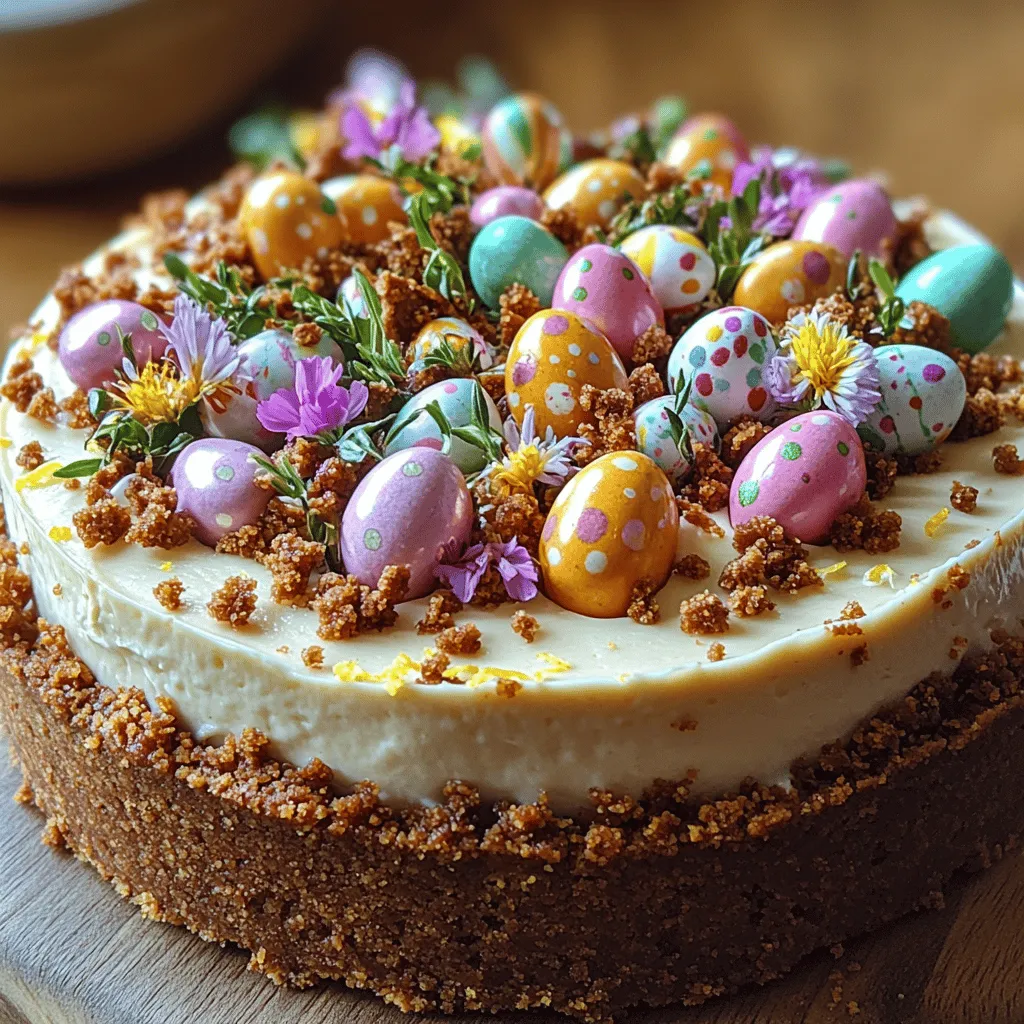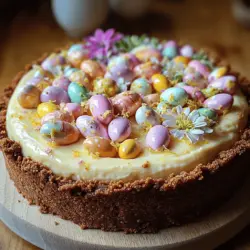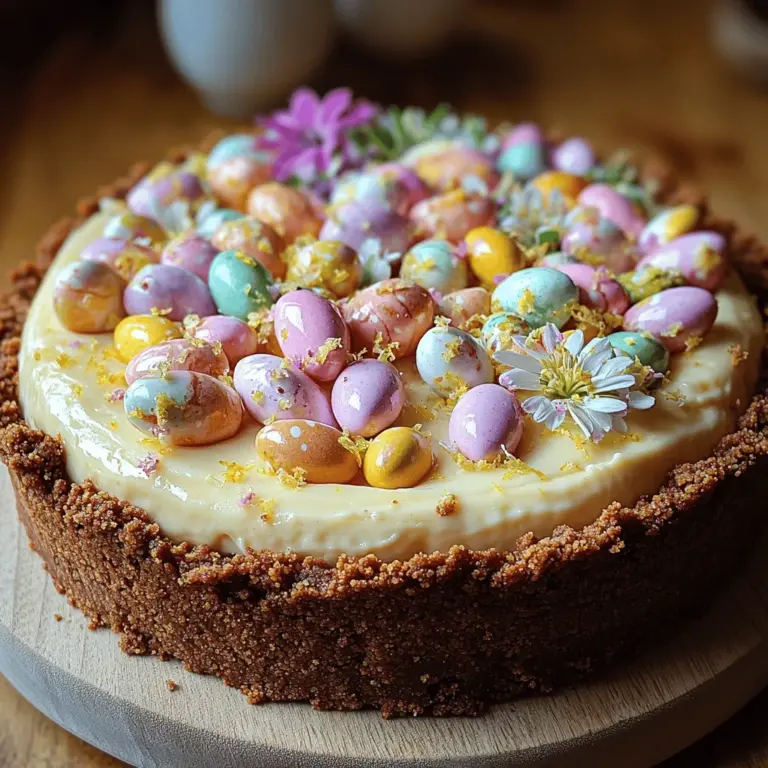Introduction
Easter is a time of renewal, celebration, and family gatherings. As one of the most significant holidays in the Christian calendar, it symbolizes the resurrection of Jesus and is often associated with themes of rebirth and new beginnings. Families around the world come together to commemorate this occasion, often indulging in festive meals and sweet treats. Among the many desserts that grace the Easter table, the Easter Cheesecake Pie stands out as a delightful choice, combining the rich, creamy goodness of traditional cheesecake with a playful and colorful presentation that captures the spirit of the season.
This delectable dessert is not only visually appealing but also offers a unique combination of flavors and textures that make it irresistible. The smooth and velvety filling, with its subtle hints of lemon, is perfectly complemented by a crunchy graham cracker and cocoa crust. The result is a cheesecake pie that is both indulgent and refreshing, making it a perfect centerpiece for your Easter celebrations. Whether you’re hosting a family gathering or attending a potluck, this Easter Cheesecake Pie is sure to impress your guests and leave them asking for seconds.
Understanding the Ingredients
To create a truly remarkable Easter Cheesecake Pie, it’s essential to understand the role of each ingredient in the recipe. Quality ingredients contribute significantly to the overall flavor and texture of the final product, and using the best components will ensure that your cheesecake pie is a standout dessert. Let’s dive into the main ingredients that make this cheesecake so special.
Cream Cheese
At the heart of any cheesecake is cream cheese, which provides the rich and creamy base that defines this dessert. Cream cheese should be softened to room temperature before mixing; this is crucial for achieving a smooth and lump-free filling. When softened correctly, cream cheese blends effortlessly with the other ingredients, resulting in a luscious texture that is both creamy and decadent.
Sour Cream
Sour cream plays a vital role in enhancing the flavor of the cheesecake filling. It adds a slight tanginess that balances the sweetness and richness of the cream cheese, creating a well-rounded flavor profile. Additionally, sour cream contributes to the smooth consistency of the filling, making it even more delightful. For the best results, opt for full-fat sour cream, as it provides the creaminess needed for a decadent dessert.
Heavy Whipping Cream
To elevate the cheesecake filling to new heights, heavy whipping cream is incorporated into the mixture. This ingredient not only adds richness but also helps create a lighter texture, making the cheesecake less dense. Whipping the cream before folding it into the filling adds airiness, resulting in a slice that feels indulgent yet light on the palate.
Fresh Lemon Juice and Zest
A key element in this Easter Cheesecake Pie is the addition of fresh lemon juice and zest. The acidity of lemon juice brightens the flavors and adds a refreshing contrast to the richness of the cream cheese and sour cream. Lemon zest, on the other hand, infuses the filling with aromatic oils, enhancing the overall flavor profile. Together, these citrus elements create a beautiful balance, making each bite a delightful experience.
Crust Ingredients: Graham Cracker Crumbs and Cocoa Powder
The crust of the Easter Cheesecake Pie is just as important as the filling. A combination of graham cracker crumbs and cocoa powder creates a unique and flavorful base that perfectly complements the creamy filling. The graham cracker crumbs provide a sweet and slightly crunchy texture, while the cocoa powder adds a hint of chocolate that elevates the overall dessert. This combination not only delivers a delightful taste but also adds a visually appealing contrast to the bright filling.
When selecting graham cracker crumbs, look for high-quality options without artificial additives. For the cocoa powder, choose unsweetened varieties, as this will allow you to control the sweetness of your cheesecake pie effectively.
Colorful Decorations
To enhance the festive spirit of your Easter Cheesecake Pie, consider using colorful decorations. Easter-themed candies, such as chocolate eggs or pastel-colored jellybeans, can be arranged on top for a playful touch. Edible flowers, such as pansies or violets, can also add a beautiful and natural element to the presentation. Not only do these decorations make the pie visually stunning, but they also contribute to the overall festive atmosphere of your Easter celebration.
Step-by-Step Instructions
With a clear understanding of the ingredients, it’s time to move on to the preparation of the Easter Cheesecake Pie. In this section, we will outline the essential steps to ensure a successful baking experience.
Preheating the Oven
Before you begin mixing your ingredients, it’s important to preheat your oven to the correct temperature. A properly heated oven is crucial for achieving the perfect cheesecake texture. Set your oven to 325°F (163°C) and allow it to preheat while you prepare the crust and filling. This step ensures that the cheesecake bakes evenly and prevents any undesirable textures from forming.
Making the Crust
Creating the crust for your Easter Cheesecake Pie is a straightforward process, but it requires attention to detail for the best results. Here’s how to do it:
1. Gather your Ingredients: Start by measuring out your graham cracker crumbs, cocoa powder, granulated sugar, and melted butter. The standard ratio is about 1 ¾ cups of graham cracker crumbs, ¼ cup of cocoa powder, and ½ cup of melted butter.
2. Mix the Dry Ingredients: In a large mixing bowl, combine the graham cracker crumbs, cocoa powder, and sugar. Mixing these dry ingredients first helps ensure that the cocoa powder is evenly distributed throughout the crust.
3. Add the Melted Butter: Pour the melted butter into the dry mixture. Using a fork or your hands, mix until all the crumbs are evenly coated with butter. The mixture should resemble wet sand and hold together when squeezed.
4. Pack the Crust: Press the crumb mixture firmly into the bottom and up the sides of a 9-inch pie dish. Ensure an even layer and compact it well; this will help the crust hold its shape during baking.
5. Bake the Crust: Place the crust in the preheated oven and bake for about 10 minutes. This step is essential to set the crust and develop a slightly crunchy texture. After baking, allow the crust to cool while you prepare the cheesecake filling.
Preparing the Filling
With the crust baked and cooled, it’s time to prepare the filling for your Easter Cheesecake Pie. Follow these steps for a smooth and creamy filling:
1. Soften the Cream Cheese: Before you begin mixing, ensure your cream cheese is softened to room temperature. This is critical for achieving a creamy, lump-free filling. If you’re short on time, you can cut the cream cheese into smaller pieces to speed up the softening process.
2. Mix the Cream Cheese: In a large mixing bowl, beat the softened cream cheese with an electric mixer on medium speed until smooth and creamy. This usually takes about 2-3 minutes. Scrape down the sides of the bowl as needed to ensure all the cream cheese is incorporated.
3. Add the Sour Cream: Once the cream cheese is smooth, add the sour cream to the bowl. Continue mixing until the two are well combined.
4. Incorporate the Heavy Whipping Cream: In a separate bowl, beat the heavy whipping cream until stiff peaks form. This step adds lightness to the filling, so take your time to whip it properly. Once stiff peaks are achieved, gently fold the whipped cream into the cream cheese mixture until fully combined.
5. Add Flavorings: Finally, stir in fresh lemon juice and lemon zest to the filling. Mix until just combined, being careful not to overmix as you want to maintain the lightness from the whipped cream.
Following these steps will result in a smooth, creamy filling that embodies the delightful flavors of your Easter Cheesecake Pie. Prepare for the next exciting stages of assembling and baking your pie, as we continue to transform these ingredients into a show-stopping dessert for your Easter celebrations.

Step-by-Step Instructions for a Creamy Texture
To achieve the perfect creamy texture for your Easter Cheesecake Pie, it’s essential to follow a few precise steps during the mixing process. Begin by ensuring all your ingredients are at room temperature; this helps them incorporate smoothly. Here’s how to proceed:
1. Prepare the Cream Cheese: In a large mixing bowl, add 24 ounces of softened cream cheese. Using an electric mixer, beat the cream cheese on medium speed until it’s smooth and free of lumps, which should take about 2-3 minutes.
2. Add Sugar: Gradually add 1 cup of granulated sugar to the cream cheese. Continue mixing on medium speed until the sugar is thoroughly incorporated, which will help create a silky texture.
3. Incorporate Eggs: Next, add 3 large eggs, one at a time, mixing well after each addition. This step is crucial as it allows the eggs to blend seamlessly into the mixture, which contributes to a creamy consistency.
4. Flavoring: Add 1 teaspoon of pure vanilla extract and the zest of 1 lemon to the mixture. These additions not only enhance flavor but also contribute to the overall texture. Mix until combined.
5. Sour Cream Addition: Finally, fold in 1 cup of sour cream gently using a spatula. This ingredient adds richness and creaminess to the cheesecake, ensuring it’s not too dense.
Baking the Cheesecake
Now that your filling is ready, it’s time to bake the cheesecake:
1. Preheat the Oven: Ensure your oven is preheated to 325°F (160°C). A consistent temperature is vital for even baking.
2. Prepare the Crust: If you haven’t done so already, press your prepared crust (graham cracker or any alternative) into a 9-inch pie dish. Make sure it’s evenly distributed across the bottom and up the sides.
3. Fill the Crust: Pour your creamy cheesecake filling into the prepared crust, spreading it evenly with a spatula.
4. Bake: Place the pie on the middle rack of the oven. Bake for about 50-60 minutes, or until the edges are set and the center still has a slight jiggle.
Tips for Ensuring the Cheesecake Bakes Evenly
– Water Bath Method: For an even bake and to prevent cracks, consider using a water bath. Wrap the bottom of your pie dish in aluminum foil to prevent water from seeping in, then place it in a larger baking pan filled with hot water. This method provides gentle heat and moisture, leading to a smoother texture.
– Avoid Overmixing: While it’s important to combine all ingredients well, avoid overmixing once the eggs are added. Overmixing can incorporate too much air, leading to cracks as the cheesecake cools.
Importance of the Jiggle Test for Perfect Doneness
The jiggle test is a simple yet effective way to check if your cheesecake is done. When you gently shake the pie dish, the center should jiggle slightly but not appear liquid. This indicates that the cheesecake is set around the edges but still creamy at the core. Remember, the cheesecake will continue to firm up as it cools, so removing it from the oven while the center is still slightly wobbly is key.
Cooling and Chilling
Cooling and chilling are crucial steps that directly impact the texture and flavor of your cheesecake:
1. Initial Cooling: After removing the cheesecake from the oven, allow it to cool in the pan at room temperature for about one hour. This gradual cooling helps prevent cracks from forming.
2. Chill in the Refrigerator: Once cooled, cover the cheesecake with plastic wrap and refrigerate it for at least 4 hours, preferably overnight. Chilling not only enhances the flavors, allowing the lemon and vanilla notes to develop, but it also helps the cheesecake firm up for easier slicing.
Decorating the Cheesecake
Decorating your Easter Cheesecake Pie adds a festive touch that appeals to both the eyes and the palate. Here are some creative ideas:
– Whipped Cream: Pipe dollops of whipped cream around the edges for a light and airy finish. You can use a star tip for a more decorative look.
– Candy Toppings: Scatter colorful Easter candies such as chocolate eggs, jelly beans, or pastel M&Ms on top. This not only creates a cheerful presentation but also enhances the flavor with a bit of crunch and sweetness.
– Fresh Flowers: For a more elegant touch, consider garnishing with edible flowers, such as pansies or violets, which can add a pop of color and a spring-like feel.
Presentation and Serving Suggestions
When it comes to serving your Easter Cheesecake Pie, presentation is key. Here are some suggestions to elevate your dessert table:
– Serve with Sauces: Accompany your cheesecake with a drizzle of fruit sauce, such as raspberry or strawberry, which adds a lovely contrast in flavor and color.
– Pair with Beverages: Consider pairing your cheesecake with beverages like coffee or herbal tea, which can complement the richness of the cheesecake. For a more festive touch, dessert wines such as Moscato or Riesling can enhance the flavors beautifully.
– Create a Dessert Table: If you’re hosting a gathering, place the cheesecake alongside other desserts like fruit tarts or chocolate mousse. This variety will appeal to different tastes and make your dessert table inviting.
Nutritional Information
Understanding the nutritional content of your Easter Cheesecake Pie can help you enjoy it in moderation while balancing indulgence with health:
– Per Serving: Each slice of cheesecake contains approximately 350 calories, 24g of fat, 30g of carbohydrates, and 5g of protein. While it is a rich dessert, it can be enjoyed as part of a balanced diet.
– Dietary Adaptations: If you’re catering to dietary preferences, consider using a gluten-free graham cracker crust or substituting some ingredients for lower-calorie options, such as light cream cheese or Greek yogurt in place of sour cream.
Serving Suggestions
To further enhance your cheesecake experience, here are some delightful serving ideas:
– Beverage Pairings: Complement your cheesecake with a hot cup of coffee, a soothing herbal tea, or a sweet dessert wine to balance the richness of the pie.
– Accompaniments: Consider offering fresh fruit, such as sliced strawberries or a fruit salad, as a side dish. This provides a refreshing contrast to the dense cheesecake and adds a touch of brightness to your dessert spread.
Conclusion
The Easter Cheesecake Pie is not just a dessert, but a delightful centerpiece that embodies the joy of the holiday season. Its creamy texture, rich flavors, and the ability to be adorned with colorful decorations make it a fabulous addition to any Easter celebration. We encourage you to try this recipe, as it promises a memorable dessert experience that you can share with family and friends. Homemade desserts like this cheesecake not only bring people together but also create lasting memories during special occasions. Celebrate this Easter with a slice of creamy joy that everyone will love!

